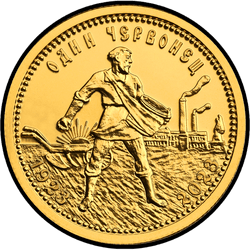in the center there is a relief image of the State Emblem of the Russian Federation, above it along the edge there is an inscription in a semicircle: "RUSSIAN FEDERATION", framed on both sides with double diamonds, below the coat of arms: on the left – the designations of precious metal and samples, on the right – the content of chemically pure metal and the trademark of the mint, at the bottom in the center in two lines – inscription: "BANK OF RUSSIA", coin denomination: "10 RUBLES"
in the center – a peasant sower at work, in the background: on the left - the rays of the rising sun, on the right – smoking factory chimneys, in the center – a field and a plow, at the top – the inscription: "ONE CHERVONETS", at the bottom – the dates: "1923" and "2023"
In October 1921, the State Bank of the RSFSR was established, which was supposed to "establish the correct monetary circulation." According to the law of October 11, 1922, the State Bank was allowed to issue hard currency partially backed by gold. Thus, the first banknotes of the State Bank – chervonets - entered the monetary circulation.
However, not only paper money was issued for circulation. Since 1923, the Petrograd Mint began to produce gold coins-chervonets, which in their parameters repeated the tsarist 10 rubles. Their design was developed by medallist Anton Vasyutinsky based on a sketch for one of the pre-revolutionary agricultural exhibitions. The full-length coin depicts a peasant sower against a background of smoking chimneys, a plow and the rising sun. Gold chervonets, dated 1923, were issued a little more than 2.7 million pieces.
52 years later, the "sower" was remembered again. In 1975, 250 thousand gold chervonets were minted, and then until 1982, a million of such coins were minted annually.
Today, the golden "sower" is one of the investment coins of the Bank of Russia
Artists: E.V. Kramskaya (obverse), A.D. Schablykin (reverse).
Sculptors: A.A. Dolgopolova (obverse), A.D. Schablykin (reverse).

 العربية
العربية беларуская мова
беларуская мова čeština
čeština dansk
dansk Deutsch
Deutsch ελληνικά
ελληνικά English
English español
español eesti
eesti suomi
suomi français
français עברית
עברית हिन्दी, हिंदी
हिन्दी, हिंदी Italiano
Italiano עברית
עברית 日本語
日本語 ქართული
ქართული 한국어
한국어 lietuvių kalba
lietuvių kalba latviešu valoda
latviešu valoda Nederlands
Nederlands język polski
język polski português
português Русский
Русский slovenčina, slovenský jazyk
slovenčina, slovenský jazyk slovenski jezik, slovenščina
slovenski jezik, slovenščina српски језик
српски језик svenska
svenska Türkçe
Türkçe українська мова
українська мова 大陆简体
大陆简体 台灣正體
台灣正體







